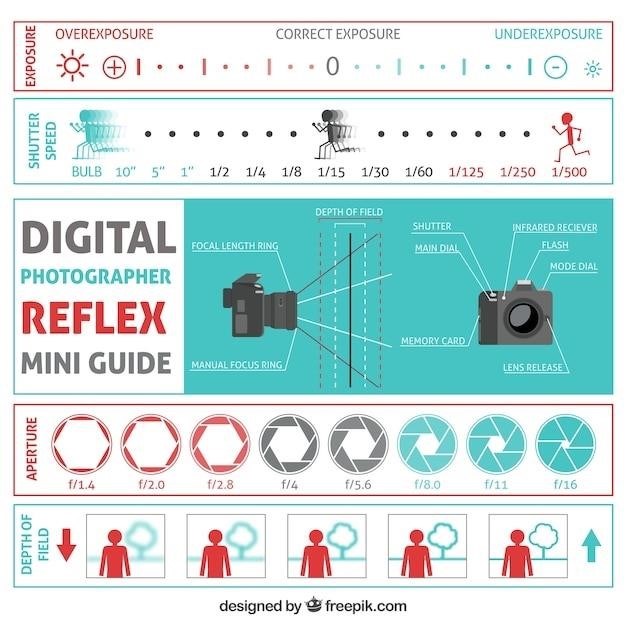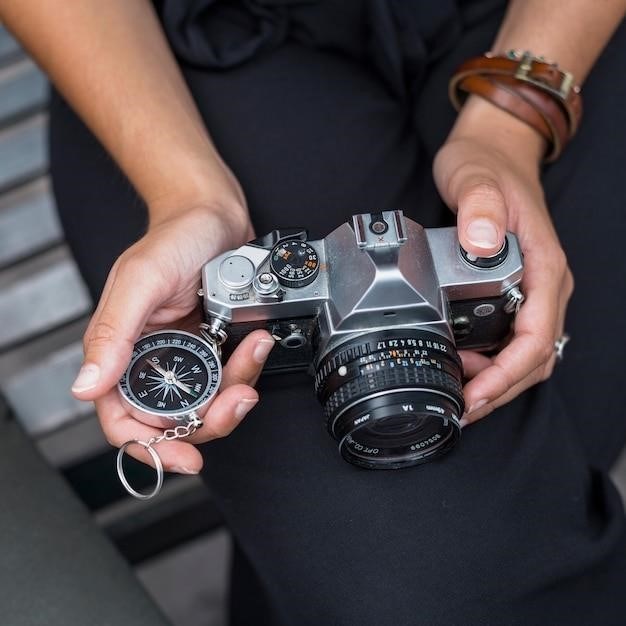Nikon FG Instruction Manual⁚ A Comprehensive Guide
This comprehensive guide provides a detailed exploration of the Nikon FG camera, a versatile and sophisticated 35mm SLR that offers a range of shooting modes, advanced photographic features, and user-friendly controls. Whether you’re a seasoned photographer or a curious beginner, this manual will empower you to understand and utilize the full capabilities of the Nikon FG.
Introduction to the Nikon FG
The Nikon FG, a 35mm SLR camera, represents a pivotal moment in Nikon’s history. Released in 1982 as a successor to the Nikon EM, the FG signaled a departure from the purely manual approach of its predecessors, embracing automation while retaining core Nikon values. Its name, a subtle nod to the esteemed F-series, hinted at a camera designed for both seasoned professionals and aspiring photographers. The FG’s compact and lightweight design, combined with its sophisticated feature set, made it an attractive choice for a wide range of users. It boasted a blend of manual and automatic exposure control, ensuring flexibility for diverse shooting scenarios.
Beyond its technological advancements, the Nikon FG also reflected the evolving landscape of photography. The rise of automated features, without sacrificing manual control, made photography more accessible and convenient. The FG’s design and capabilities epitomized this shift, allowing photographers to explore a wider range of photographic possibilities.
Key Features and Capabilities
The Nikon FG is a testament to Nikon’s commitment to providing photographers with a versatile and feature-rich camera. It boasts a comprehensive set of capabilities that cater to a wide range of shooting styles. One of its key strengths is its array of exposure modes, encompassing Programmed, Aperture-Priority Automatic, and Full Manual control. This flexibility allows photographers to adapt their approach based on the specific shooting situation, ensuring optimal results in diverse lighting conditions.
Beyond exposure control, the FG is equipped with advanced photographic features designed to enhance image quality and creative control. These features include an exposure compensation dial, an exposure compensation button, and an audio warning system. The FG also integrates seamlessly with Nikon’s Speedlight system, offering TTL metering for accurate flash exposure. This combination of features empowers photographers to fine-tune their images and achieve a level of precision that was previously only attainable with more complex cameras.
Shooting Modes
The Nikon FG offers a selection of shooting modes designed to cater to different photographic scenarios and skill levels. At the heart of its versatility lies the inclusion of both automatic and manual exposure control. The “P” (Program) mode provides a fully automatic experience, where the camera intelligently selects both shutter speed and aperture for optimal exposure. This mode is ideal for beginners or for situations where speed and ease of use are paramount.
For photographers seeking greater control, the FG provides two additional modes⁚ “A” (Aperture-Priority Automatic) and “M” (Manual). In Aperture-Priority mode, the photographer sets the desired aperture, and the camera automatically chooses the appropriate shutter speed to maintain proper exposure. This mode is favored by photographers who want to control depth of field, a crucial element in portraiture and landscape photography. Finally, Manual mode grants the photographer complete control over both shutter speed and aperture, allowing for the most creative freedom and precise control over exposure.
Manual Exposure Control
The Nikon FG’s Manual mode empowers photographers to take complete control over their exposure settings, offering the ultimate creative freedom; In this mode, the photographer manually selects both the shutter speed and aperture, allowing for precise adjustments to match the specific lighting conditions and desired effect. By understanding the interplay between shutter speed and aperture, photographers can manipulate the exposure to achieve a range of artistic outcomes. A slower shutter speed allows for capturing motion blur in dynamic subjects, while a faster shutter speed freezes action in fast-paced moments. Similarly, a wider aperture (smaller f-number) creates a shallow depth of field, isolating the subject from the background, while a narrower aperture (larger f-number) increases the depth of field, ensuring that both foreground and background elements are in focus.
The Nikon FG’s manual exposure control is a powerful tool for photographers who desire absolute creative control. It allows for precise adjustments based on individual artistic vision and the specific demands of the photographic situation.
Aperture-Priority Automatic Exposure
For photographers who prefer to prioritize depth of field control while letting the camera handle shutter speed adjustments, the Nikon FG’s Aperture-Priority Automatic Exposure mode is an invaluable tool. In this mode, the photographer selects the desired aperture, and the camera automatically sets the corresponding shutter speed to achieve a proper exposure. This allows photographers to maintain creative control over the depth of field while relying on the camera’s metering system to ensure accurate exposure. A wider aperture (smaller f-number) creates a shallow depth of field, isolating the subject from the background, while a narrower aperture (larger f-number) increases the depth of field, ensuring that both foreground and background elements are in focus.
Aperture-Priority Automatic Exposure is particularly well-suited for portrait photography, where a shallow depth of field is often desired to blur the background and emphasize the subject. It is also useful for landscapes, where a wider aperture can be used to capture the vastness of the scene, while a narrower aperture can be used to ensure that all elements are in focus. The Nikon FG’s Aperture-Priority Automatic Exposure mode offers a balance between creative control and automatic convenience, making it a versatile option for a wide range of photographic scenarios.
Programmed Automatic Exposure
The Nikon FG’s Programmed Automatic Exposure mode simplifies the shooting process by allowing the camera to automatically set both aperture and shutter speed. This mode is ideal for photographers who prefer to focus on composition and subject matter rather than technical settings. The camera intelligently selects the optimal aperture and shutter speed combination based on the prevailing lighting conditions, ensuring accurate exposure and minimizing the need for manual adjustments. This automation makes it particularly suitable for capturing spontaneous moments or situations where quick shooting is essential.

The Nikon FG’s Programmed Automatic Exposure mode also incorporates a feature known as “Program Shift,” which allows photographers to fine-tune the camera’s exposure settings within a limited range. By rotating the aperture ring on the lens, photographers can adjust the aperture and shutter speed combination while staying within the parameters of the programmed mode. This flexibility allows photographers to exert some creative control over the exposure, while still enjoying the convenience of automatic settings. The Nikon FG’s Programmed Automatic Exposure mode provides a balance between automation and creative control, making it a reliable and user-friendly option for a wide range of photographic situations.
Advanced Photographic Features
The Nikon FG goes beyond basic shooting modes, offering a suite of advanced photographic features designed to enhance your creative control and image quality. One notable feature is the exposure compensation dial, which allows you to adjust the overall exposure level by up to two stops in either direction. This is particularly useful for fine-tuning exposure in challenging lighting conditions or when you want to create specific effects like underexposure for a dramatic look. The Nikon FG also incorporates an exposure compensation button, which provides a quick and convenient way to adjust exposure levels during shooting without having to access the main dial.
Further enhancing your creative capabilities, the Nikon FG features an audio warning system. This feature alerts you when the camera detects potential exposure problems, such as when the shutter speed is too slow or the aperture is too small. This audio feedback helps you avoid potential overexposure or underexposure issues, ensuring that you capture well-exposed images. The Nikon FG also supports TTL (Through The Lens) flash metering, allowing for accurate flash exposure control. Coupled with the advanced features mentioned above, the Nikon FG empowers you to capture professional-quality images with creative flexibility and precision.
Using the Nikon FG⁚ A Step-by-Step Guide
Mastering the Nikon FG is a straightforward process, thanks to its user-friendly design and intuitive controls. Begin by installing the battery or batteries, ensuring they are correctly positioned within the battery compartment. With the battery installed, proceed to load the film. Open the back of the camera, insert the film cassette, and close the back securely. After loading the film, advance it until the film leader is visible in the film rewind window. Now, you can begin shooting. Choose your desired shooting mode, select the appropriate aperture and shutter speed settings, and compose your shot through the viewfinder. Once you’re ready, gently press the shutter release button to capture your image.
To advance the film to the next frame, use the film advance lever. After shooting a roll of film, rewind the film back into the cassette using the film rewind crank. Once the film is rewound, you can remove the film cassette from the camera. Throughout the process, pay attention to the LED viewfinder indicators, which provide crucial information about camera settings, battery status, and other important details. By following these simple steps, you’ll be well on your way to capturing stunning photographs with your Nikon FG.
Troubleshooting and Maintenance
While the Nikon FG is a robust camera, occasional issues can arise. If you encounter problems, consult the troubleshooting section of this manual for guidance on resolving common issues such as a stuck shutter, an empty battery, or an error in the exposure meter. Regular cleaning and maintenance are essential for ensuring the longevity of your Nikon FG. Clean the camera body and lens with a soft, lint-free cloth. Avoid using harsh chemicals or abrasive materials that could damage the camera’s finish. For more thorough cleaning, consult a professional camera technician.
If you notice any signs of malfunction or damage, it’s best to seek professional repair services. Contact an authorized Nikon service center or a reputable camera repair technician to address any issues that require specialized expertise. By following these troubleshooting and maintenance tips, you can keep your Nikon FG in top condition and ensure it continues to provide years of reliable service.
Where to Find the Nikon FG Instruction Manual
Accessing a Nikon FG instruction manual is relatively straightforward. Online resources like ManualsLib, OrphanCameras, and the M. Butkus Library offer free downloadable PDF versions. These websites provide comprehensive guides covering all aspects of the camera, from basic operation to advanced features. You can search for “Nikon FG instruction manual” or “Nikon FG-20 instruction manual” on these platforms. Additionally, eBay often features listings for physical copies of the manual, though these might come at a cost.
For a more interactive experience, consider visiting the Nikon website, which may offer online documentation for some of their older models. Remember, the manual is your ultimate guide to mastering the Nikon FG, so take the time to explore it thoroughly and unlock its full potential.
